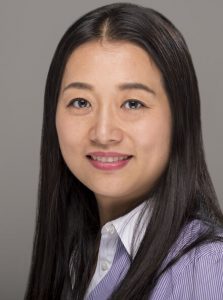
Xue awarded $400,000 to develop computer model that simulates irregular voice conditions

Developing a computer model that can provide an accurate, real-time simulation of irregular voice conditions is the focus of a two-year study being led by a University of Maine researcher.
Qian Xue, an assistant professor of mechanical engineering, is leading the project that aims to understand how alterations in vocal fold anatomy affect glottal flow, vocal fold vibrations and voice acoustics.
Xue recently was awarded $406,984 from the National Institute on Deafness and Other Communication Disorders (NIDCD), part of the National Institutes of Health, for the project, “Development of an accurate and real-time voice simulator for voice disorders.”
The overall objective of the project is to develop a high-fidelity computer model for simulating mucosal wave on vocal fold and voice outcomes in various irregular vocal conditions.
When vocal folds vibrate, superficial tissue is displaced in a wave-like fashion, creating a mucosal wave, which is known as the fundamental element of vocal fold vibration in mammals, according to Xue.
Through motion, the mucosal wave controls the rise and fall in the amount of air flowing through the glottis, or the part of the larynx that contains the vocal cords and the opening between them. The glottal air pulses form the primary sound sources of the voice. Vocal fold pathologies often alter the anatomy — morphology and material properties — of vocal fold, resulting in irregular mucosal waves, which are often associated with voice symptoms including hoarseness, breathy voice and voice fatigue, Xue says.
Despite nearly 40 years of development, a computer model that can accurately simulate the spatiotemporal dynamics of glottal flow, mucosal wave and voice acoustics associated with various vocal pathologies in realistic vocal fold anatomies does not exist, according to Xue.
Continuum vocal fold models are limited due to a lack of accurate and rapid computation of flow pressures in irregular glottal shapes. The Navier-Stokes equation is able to compute the correct flow pressures for irregular shapes, however, it is expensive and not suitable for clinical use, according to Xue.
Xue says the proposed model could further the understanding of the relationship between vocal fold biomechanics, mucosal wave patterns and the resulting voice.
“It will be very useful for answering the questions of how alterations in vocal fold anatomy affect mucosal wave and voice outcomes and what alterations have led to the observed irregular wave patterns and voices,” she says. “Such knowledge is essential to improving the diagnosis and treatment of many vocal fold pathologies, such as vocal fold nodules, cysts, polyps, tumors, paralysis, scarring, etc.”
The project is a collaborative research effort between UMaine’s Mechanical Engineering Department and the National Center for Voice and Speech. It was awarded an Exploratory/Developmental Grant from NIDCD.
The Exploratory/Developmental Grant program is intended to support the early and conceptual stages of projects. The studies may involve considerable risk but may lead to a breakthrough in a particular area or to the development of novel techniques, agents, methodologies, models or applications that could have a major impact on a field of biomedical, behavioral or clinical research, according to NIDCD.
Contact: Elyse Catalina, 581.3747
